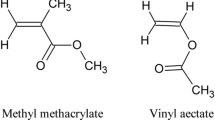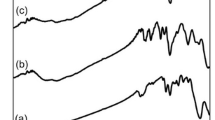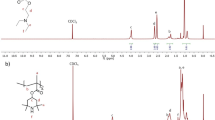Abstract
The molecular motion of imidazole (Im) in proton-conducting polyacrylic acid (PAA)/Im composite materials (PAA/xIm, where x represents the number of moles of Im per mole of the carboxyl group of PAA) was investigated using solid-state 2H NMR. For the 2H NMR analysis of polymers in which multiple constituents with different kinetic states coexist, we propose the simultaneous analysis of two 2H NMR spectra observed by the quadruple echo method using different echo intervals. The 2H NMR spectra were analyzed by superimposing simulated spectra with different jumping rates of 180° flip and isotropic rotation of Im. For PAA/0.5Im-d3, Im undergoes 180° flip below 343 K and isotropic rotation above 363 K. For PAA/1.0Im-d3, Im undergoes 180° flip below 323 K and isotropic rotation above 363 K. In the temperature range of 333–343 K, Im undergoing 180° flip and isotropic rotation coexist in PAA/1.0Im-d3. The distributions of the jumping rates of 180° flip and isotropic rotation of Im were obtained. The increase in the amount of Im enhances the jumping rate of the isotropic rotation of Im and the proton conductivity of PAA/xIm at high temperatures.
Similar content being viewed by others
Avoid common mistakes on your manuscript.
1 Introduction
Anhydrous proton-conducting polymers that are accessible above 100 °C have been widely researched for applications in solid electrolyte fuel cells. Several proton-conducting polymer/imidazole (Im) composites have been proposed [1,2,3,4,5,6,7]. In these composites, Im molecules are intercalated into a polymer with acidic groups to provide a proton conduction path. For the proton conduction of polymer/Im composites induced by continuous proton transfer in the hydrogen bond network created by Im molecules (Grotthuss mechanism), the reorientational motion of Im molecules play a pivotal role [8,9,10,11]. Particularly, in the polyacrylic acid (PAA)/Im composite material (PAA/xIm, where x represents the number of moles of Im per mole of the carboxyl group of PAA) (Scheme 1), the proton conductivity (PC) increases with x, indicating that Im is the proton carrier [3]. The PC also increases with temperature and is on the order of 10− 3 and 10− 4 S/cm at 393 K for x = 1.0 and 0.5, respectively. In this study, we analyzed the molecular motion of Im in PAA/xIm using solid-state 2H NMR spectroscopy, and the correlation between molecular motion and PC was discussed. 2H nuclear spin, I = 1. Therefore, the solid-state 2H NMR spectrum line shape is dominated by the nuclear quadrupolar interaction and is affected by molecular motion. The molecular motion mode and rate can be obtained by the ²H NMR broadline spectrum line shape analysis of a powder sample using spectral simulation [12,13,14,15,16]. For the line shape analysis of polymers in which multiple constituents with different kinetic states coexist, we propose the simultaneous analysis of two 2H NMR spectra observed by the quadruple echo method using different echo intervals.
2 Experimental details
PAA and Im were dissolved in water and stirred for several days. The resulting solution was transferred to a polytetrafluoroethylene Petri dish and dried to obtain composite films. The obtained thin films with approximately 0.2-mm thickness were dried under vacuum at 50 °C for 24 h. Deuterated Im (Im-d3), in which three of the hydrogens bonded to the carbon, was employed for 2H NMR measurements. PAA/xIm-d3 films were inserted into a screw-top NMR sample tube with an O-ring.
2H NMR was performed using a JEOL ECA-300 spectrometer at 45.282 MHz under nitrogen gas flow. The 2H NMR broadline spectra were measured using a quadrupole-echo sequence (90˚)x– τ– (90˚)y– τ– tacq, where τ and tacq denote the intervals of echo and acquisition time, respectively, and the 90˚ pulse width is 2.8 µs. The time evolution of magnetization in the quadrupole-echo sequence was calculated by incorporating the effects of quadrupolar interactions and molecular motion to obtain echo signals using homemade Fortran programs with double precision [15, 16]. Simulated 2H NMR spectra were obtained by Fourier transformation of the calculated echo signals. A series of simulation spectra with different jump rates k were produced in the range of 102–1010 Hz for the 180° flip and isotropic rotation of Im (Scheme 2).
For the 180° flip simulation, the superposition of the exchange spectrum between D2 and D3 and the static D1 spectrum was calculated. The quadrupole coupling constant e2qQ/h = 170 kHz and asymmetry parameter η = 0.1 were used for the calculation. A truncated icosahedral (60-site) model was employed to simulate the isotropic rotation of Im, and jumps between nearest-neighbor sites were assumed [17]. e2qQ/h = 170 kHz and η = 0.0 were used to calculate the isotropic rotation. The superposition of the simulation spectra was fitted to the experimental spectra. The weighting factors of each simulation spectrum were determined using the constrained least squares method [18, 19].
2H NMR spectrum line shape and intensity depend on the length of τ. Therefore, the distribution of k that simultaneously reproduces the 2H NMR spectra observed by τ = 20 and 40 µs was determined.
3 Results and discussion
Figure 1 shows the temperature dependence of 2H NMR broadline spectra observed by the echo interval of τ = 20 and 40 µs for PAA/xIm-d3 (x = 0.5 and 1.0) below 343 K. The 2H NMR broadline spectrum line shape in this temperature range can be reproduced by the 180° flip of Im for x = 0.5. For x = 1.0, the 2H NMR broadline spectrum line shape was reproduced by the 180° flip of Im below 323 K, and the component around 0 kHz induced by the isotropic rotation appeared above 333 K. Fitting calculations to the spectra measured below 343 K for x = 0.5 and below 323 K for x = 1.0 were performed by superimposing the simulated spectra with different jumping rates of 180° flip of Im. The spectra for x = 1.0 at 323 and 343 K were analyzed by superimposing the simulated spectra with different jumping rates of 180° flip and isotropic rotation of Im. The results of the fitting are indicated by the red lines in Fig. 1.
Figure 2 shows the distributions of jumping rates of 180° flip (k180˚) of Im obtained by fitting the 2H NMR spectral data, while Fig. 3 shows the distributions of jumping rates of 180° flip and isotropic rotation of Im at 333 and 343 K for x = 1.0. In the temperature range of 293–323 K, the k180˚ of the main component varied from the order of 104 to 106 Hz. A static component appeared in addition to the main component. For the simulation of spectrum, Im in 180° flip is used to calculate the superposition of the exchange spectrum between D2 and D3and the static D1 spectrum in Scheme 2. Therefore, the contribution of static D1 in Im undergoing 180° flip is not included in the static component below 323 K in Fig. 2. The 2H NMR spectrum line shapes and intensities are almost identical at jumping rates below 102 Hz. Therefore, the static component corresponds to Im without 180° flip or Im with jumping rate k180˚ ≤ 102 Hz. There was no significant temperature change in the ratio of the static component. The ratio of the static component was 17% ± 1% and 27% ± 5% for x = 0.5 and 1.0, respectively. The hydrogen bond between Im and the carboxy group in PAA was confirmed by infrared spectroscopy [3]. The 180° flip is attributable to Im hydrogen bonding to a carboxy group. Meanwhile, some Im formed aggregates in polymer composites, and the aggregated Im increased with the Im content in the polymer [20]. The aggregated Im melts at approximately 333 K for poly(vinylphosphonic acid) (PVPA)/Im composite [20]. Thus, the static component of PAA/Im-d3 is predicted to include aggregated Im.
Above 333 K, there is no static component while an additional 180˚ flip component appeared around 105 Hz for x = 0.5 (Fig. 2(a)) and an isotropic rotational component appeared around 106 Hz for x = 1.0 (Fig. 3).
Figure 4 shows the Arrhenius plot of the jumping rate of 180° flip of Im for PAA/xIm-d3 (x = 0.5 and 1.0). The activation energy of 180° flip of Im was estimated to be 46 kJ/mol for x = 1.0.
Figure 5 shows the temperature dependence of the 2H NMR broadline spectra observed by the echo interval of τ = 20 and 40 µs for PAA/xIm-d3 (x = 0.5 and 1.0) above 363 K. The 2H NMR broadline spectrum line shapes in this temperature range represent the isotropic rotation of Im. Fitting calculations to the measured spectra were performed by superimposing the simulated NMR spectra with different jumping rates of the isotropic rotation of Im. The results of the fitting are indicated by the red lines in Fig. 5.
Figure 6 shows the distributions of the jumping rates of the isotropic rotation (kiso) of Im obtained by fitting the 2H NMR spectral data. For x = 0.5, two components were identified below 383 K.
Figure 7 shows the Arrhenius plot of the jumping rate of isotropic rotation of Im for PAA/xIm-d3 (x = 0.5 and 1.0). At each temperature, the jumping rate of the isotropic rotation of Im for x = 1.0 was faster than that for x = 0.5. The activation energy Ea of the isotropic rotation of Im was estimated to be 95 kJ/mol for x = 1.0.
From the 2H NMR spectrum analysis, Im in PAA/xIm undergoes 180˚ flip at low temperatures and isotropic rotation at high temperatures.
The slope of the temperature dependence of PC changed at approximately 343 K and slowed down at higher temperatures for PAA/xIm. Bozkurt et al. [3] interpreted the PC trend of PAA/xIm as the Vogel − Tamman − Fulcher behavior. The activation energies of the PC for x = 1.0 can be estimated to be approximately 90 and 140 kJ/mol in the high-temperature range (343–383 K) and low-temperature range (283–323 K), respectively. The 180˚ flip of Im is considered to contribute to PC in the low-temperature range. However, the activation energy of 180˚ flip of Im (46 kJ/mol) was smaller than that of the PC at low temperatures, attributable to the static component that prevents proton conduction. Meanwhile, the activation energy for PC at x = 1.0 in the high-temperature range is comparable to that for the isotropic rotation of Im (95 kJ/mol), indicating that the isotropic rotation of Im is strongly related to PC.
In bare PAA, the carboxy groups form dimers through hydrogen bonding and the polymer chains are tightly linked to each other. The intercalation of guest molecules is predicted to break the hydrogen bond in the dimer of the carboxy groups in PAA and relaxes the polymer chain packing [21]. Consequently, the glass transition temperature Tg of bare PAA is 378 K and is shifted to 308 K for PAA/1.0Im [3]. The flexibility of PAA/xIm increases as the amount of Im introduced increases. The Tg of PAA/1.0Im is lower than that of PAA/0.5Im by more than 10 K. An increase in the flexibility of the polymer composite increases the jumping rate of the isotropic rotation of Im and enhances PC.
4 Conclusion
In this study, the molecular motion of Im in PAA/xIm-d3 (x = 0.5 and 1.0) composites with multiple components in different kinetic states of motion was investigated by 2H NMR spectroscopy. Below 343 K, Im undergoing 180˚ flip was observed. Static Im was observed in addition to Im undergoing 180˚ flip below 323 K. Above 363 K, Im undergoing isotropic rotation was observed. The jumping rate of the isotropic rotation of Im in PAA/1.0Im-d3 was faster than that in PAA/0.5Im-d3. The intercalation of Im breaks the hydrogen bond in the dimer of the carboxy groups in PAA and relaxes the packing of the polymer chains. An increase in the amount of Im is expected to increase the polymer membrane flexibility and the jumping rate of the isotropic rotation of Im. Moreover, an increase in the jumping rate of the isotropic rotation of Im enhances the PC of PAA/xIm.
Data availability
No datasets were generated or analysed during the current study.
References
Kreuer, K.D., Fuchs, A., Ise, M., Spaeth, M., Maier, J.: Imidazole and pyrazole-based Proton conducting polymers and liquids. Electrochim. Acta. 43, 1281–1288 (1998)
Schechter, A.: Imidazole and 1-Methyl Imidazole in Phosphoric Acid Doped Polybenzimidazole, Electrolyte for fuel cells. Solid State Ionics. 147, 181–187 (2002)
Bozkurt, A.: PAA/Imidazole-Based Proton Conducting Polymer Electrolytes. J. Power Sources. 123, 126–131 (2003)
Sevil, F., Bozkurt, A.: Proton Conducting Polymer Electrolytes on the basis of poly(Vinylphosphonic Acid) and Imidazole. J. Phys. Chem. Solids. 65, 1659–1662 (2004)
Çelik, S., Bozkurt, A., Hosseini, S.S.: Alternatives toward Proton Conductive Anhydrous membranes for fuel cells: Heterocyclic Protogenic solvents Comprising Polymer Electrolytes. Prog Polym. Sci. 37, 1265–1291 (2012)
Yamada, M., Honma, I.: Alginic Acid–Imidazole Composite Material as Anhydrous Proton conducting membrane. Polymer. 45, 8349–8354 (2004)
Yamada, M., Honma, I.: Anhydrous Proton Conducting Polymer Electrolytes based on poly(Vinylphosphonic Acid)-Heterocycle Composite Material. Polymer. 46, 2986–2992 (2005)
Kawada, A., McGhie, A.R., Labes, M.M.: Protonic Conductivity in Imidazole Single Crystal. J. Chem. Phys. 52, 3121–3125 (1970)
Bureekaew, S., Horike, S., Higuchi, M., Mizuno, M., Kawamura, T., Tanaka, D., Yanai, N., Kitagawa, S.: One-Dimensional Imidazole Aggregate in Aluminium Porous Coordination polymers with High Proton Conductivity. Nat. Mater. 8, 831–836 (2009)
Mizuno, M., Iwasaki, A., Umiyama, T., Ohashi, R., Ida, T.: Local structure and Dynamics of Imidazole Molecules in Proton-conducting poly(Vinylphosphonic Acid)– Imidazole Composite Material. Macromolecules. 47, 7469–7476 (2014)
Hori, Y., Chikai, T., Ida, T., Mizuno, M.: Local structure and Hydrogen Bond Characteristics of Imidazole Molecules for Proton Conduction in Acid and Base Proton-conducting Composite materials. Phys. Chem. Chem. Phys. 20, 10311–10318 (2018)
Vold, R.R., Vold, R.L.: In: Warren, W.S. (ed.) Advances in Magnetic and Optical Resonance, vol. 16, pp. 85–171. Academic Press Inc, San Diego (1991)
Vold, R.R.: In: Tycko, R. (ed.) Nuclear Magnetic Resonance Probes of Molecular Dynamics, pp. 27–112. Kluwer Academic, Norwell, MA (1994)
Schmidt-Rohr, K., Spiess, H.W.: Multidimensional Solid-State NMR and Polymers. Academic, London (1994)
Mizuno, M.: Experimental Approaches of NMR Spectroscopy, ed. The Nuclear Magnetic Resonance Society of Japan, vol. 12, pp. 341–364. Springer (2018)
Araya, T., Niwa, A., Mizuno, M., Endo, K.: Dynamics of [Zn(D2O)6]2+ in [Zn(D2O)6][SiF6] crystal as studied by 1D, 2D Spectra and spin-lattice relaxation time of 2H NMR. Chem. Phys. 344, 291–298 (2008)
Metin, B., Blum, F.D.: Molecular Mass and Dynamics of Poly(Methyl Acrylate) in the Glass-Transition Region. J. Chem. Phys. 124, 054908 (2006)
Bro, R., Jong, S.D.: A fast non-negativity-constrained least squares Algorithm. J. Chemom. 11, 393–401 (1997)
Watanabe, R., Kurihara, T., Shigeta, Y., Amemori, S., Yamaguchi, N., Ishii, F., Ida, T., Mizuno, M.: Structural and physical properties of proton-conducting polyacrylic acid/ alginic acid/1,2,4-Triazole composite membranes. Solid State Ionics. 399, 116299 (2023)
Mizuno, M., Narita, T., Une, R., Ohashi, R., Ida, T.: Solid-state NMR study of excess imidazole in a Proton-conducting poly(Vinylphosphonic Acid)-Imidazole Composite. Chem. Lett. 47, 411–413 (2018)
Sahm, M., Oprea, A., Bârsan, N., Weimar, U.: Interdependence of Ammonia and Water Sorption in Polyacrylic Acid Layers, Sens. Actuators B. 130, 502–507 (2008)
Acknowledgements
This work was supported by JSPS KAKENHI Grant Numbers JP19H02554 and JP22H01889.
Funding
Open Access funding provided by Kanazawa University.
Author information
Authors and Affiliations
Contributions
M. M. formulated the idea of this study. All authors made significant contributions to the concept, design, execution, or interpretation of the research study. All authors prepared and reviewed the manuscript equally.
Corresponding author
Ethics declarations
Ethical approval
No applicable.
Competing interests
The authors declare no competing interests.
Additional information
Publisher’s Note
Springer Nature remains neutral with regard to jurisdictional claims in published maps and institutional affiliations.
Rights and permissions
Open Access This article is licensed under a Creative Commons Attribution 4.0 International License, which permits use, sharing, adaptation, distribution and reproduction in any medium or format, as long as you give appropriate credit to the original author(s) and the source, provide a link to the Creative Commons licence, and indicate if changes were made. The images or other third party material in this article are included in the article’s Creative Commons licence, unless indicated otherwise in a credit line to the material. If material is not included in the article’s Creative Commons licence and your intended use is not permitted by statutory regulation or exceeds the permitted use, you will need to obtain permission directly from the copyright holder. To view a copy of this licence, visit http://creativecommons.org/licenses/by/4.0/.
About this article
Cite this article
Mizuno, M., Hosoe, N., Kurihara, T. et al. Solid-state 2H NMR investigation of molecular motion in proton-conducting polyacrylic acid/imidazole composites. Interactions 245, 33 (2024). https://doi.org/10.1007/s10751-024-01867-4
Accepted:
Published:
DOI: https://doi.org/10.1007/s10751-024-01867-4













